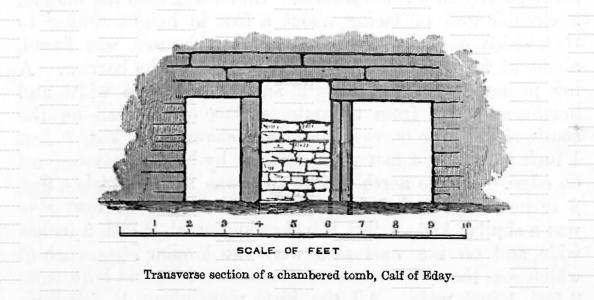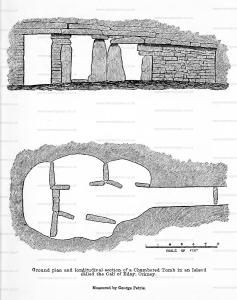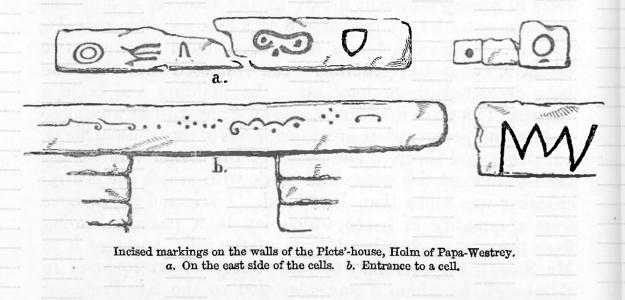Europe, British Isles, Scotland, Orkney Islands, Orkney Northern Islands, Eday
Eday, Orkney is in Orkney Northern Islands.
Europe, British Isles, Scotland, Orkney Islands, Orkney Northern Islands, Calf of Eday
Europe, British Isles, Scotland, Orkney Islands, Orkney Northern Islands, Calf of Eday Chambered Cairns [Map]
Calf of Eday Chambered Cairns is also in Orkney Chambered Cairns Unspecified Type.
Archaeological Journal Volume 20 Section III. In the Calf of Eday, a small island, now uninhabited, there is what I consider another variety of the chambered tombs [Calf of Eday Chambered Cairns [Map]]. It is wholly subterranean, situated in the face of a slope, and it consists of a central chamber with four surrounding cells, formed by upright flagstones, with the usual passage from the outside to the interior. (See the accompanying ground-plan and section.) Beneath the outer extremity of the passage or entrance, a drain was discovered, indicated in the plan, and was traced some distance down the hill-side. The plan will show how closely the building resembles in its internal arrangements, not only the Bookan barrow, but also the so-called Picts'-houses. The same structural design evidently pervades the whole.
The interior measurement, from the extremity of the entrance passage, where the transverse drain above mentioned is indicated in the ground-plan, is 16 ft. 6 in. by about 6 ft. 6 in. in width across the middle of the building. The width of the passage is 1 ft. 8 in.; its height, 3 ft.; the opening to the central cell, 2 ft. 4 in; the largest of the lateral cells measures about 4 ft. 6 in. by 2 ft. 6 in.; the innermost cell measures 6 ft. 2 in. bj 2 ft. 6 in., and in height 4 ft. 6 in. The central cell measures only 4 ft. in height.


Europe, British Isles, Scotland, Orkney Islands, Orkney Northern Islands, Eday, Huntersquoy Chambered Cairn [Map]
Huntersquoy Chambered Cairn is also in Orkney Cromarty Type Chambered Cairn.
Huntersquoy Chambered Cairn [Map] is an Orkney–Cromarty type chambered cairn.
Europe, British Isles, Scotland, Orkney Islands, Orkney Northern Islands, Eday, Vinquoy Chambered Cairn [Map]
Vinquoy Chambered Cairn is also in Maeshowe Type Chambered Cairn.
Vinquoy Chambered Cairn [Map]. A Maes-Howe-Type chambered cairn, now overgrown with heather, was excavated by Farrer and Hebden, in 1857 (G Petrie 1863) who are presumably responsible for the shallow depression in the top of the cairn to gain access to the chamber through the roof. The cairn, much disturbed at the edges, appears to have been about 58' in diameter. Built on a gentle slope the height on the north side appears to be 4' while on the south it is about 8'. It does not seem to have been much higher and probably only just covered the lintels,for it rises only 2' above the present wall-head of the chamber.
Archaeological Journal Volume 20 Section III. These buildings are numerous in Orkney, and are generally in some prominent place, as the brow of a hill—the sea-side—an islet by the margin of a lake—or other similar locality. Human skeletons have been found in one or two of them, but it has generally been supposed that they had been deposited there long after the building had become ruinous. I found in the Picts'-house on Wideford-hill [Map], which was in excellent preservation, great quantities of the bones of horse, ox, swine, and sheep. The bones of the larger animals lay lowest amongst the stones and earth with which the central chamber was more than half filled. I selected a jaw-bone from a quantity of bones which lay in a passage leading from the central chamber to one of the cells, and sent it to Mr. Stuart, the secretary of the Society of Antiquaries in Edinburgh, by whom it was submitted to the late Professor Quekett of London, who pronounced it to be a relic of the species bos longifrons. The discovery of the remains of an animal which is believed to have become extinct in Britain about the time of the Roman invasion, shows the importance of preserving all animal remains which may be found in the aboriginal structures, and is at the same time an evidence of the antiquity of the buildings in which such remains are discovered. The bones were deposited in the mouths of the passages leading to the cells, as if the animals had been intended to be offerings to the deities, or to the manes of the departed. The accompanying plan and section of a Picts'-house in the Island of Eday [Vinquoy Chambered Cairn [Map]], which was opened in 1857 by Robert J. Hebden, Esq., of Eday, and James Farrer, Esq., M.P., will convey a general idea of those interesting structures. The following are the measurements of the various chambers in this Picts'-house;—
A. The central chamber, 6 ft 9 in. by 5 ft.; height 10 ft.
B. 5 ft. 6 in. by 2 ft. 3 in.; height 5 ft.; the length of the passage of approach to this chamber from the central one is about 3 ft. 6 in., its width about 1 ft. 9 in.
C. 5 ft. by 4 ft.; height 6 ft.; the width of the passage of approach, 1 ft. 3 in.
D. 4 ft. 6 in. by 3 ft.
E. 5 ft. 6 in. by 3 ft.
F. Entrance passage, 12 ft. in length, 1 ft. 8 in. in width, 3 ft. in height. It was continued beyond the encircling WALL, G G
